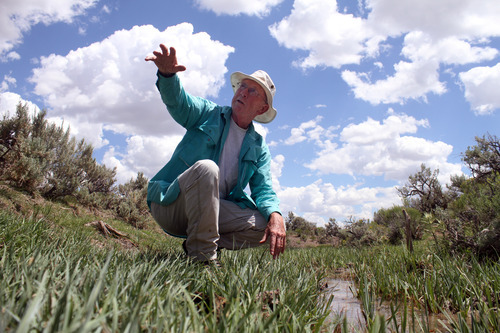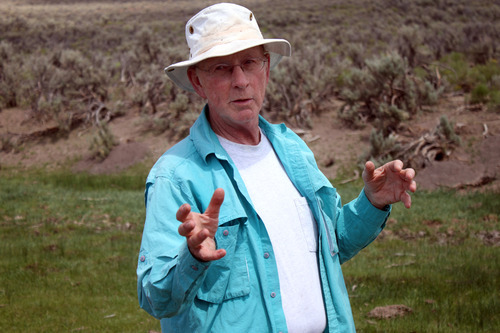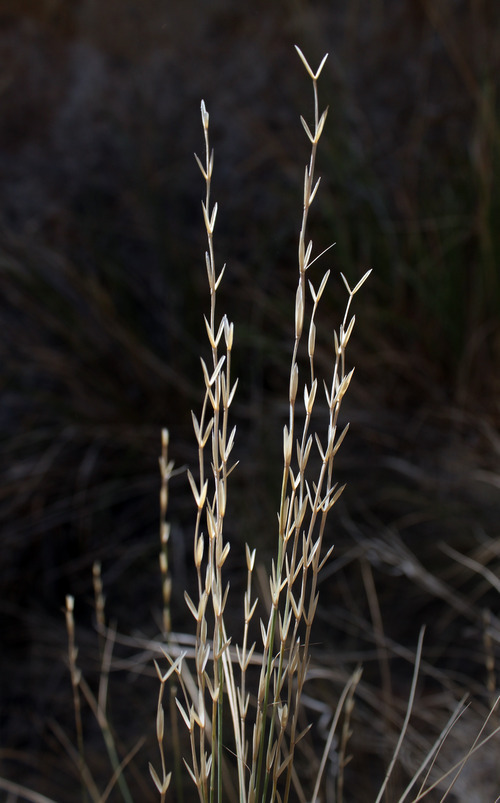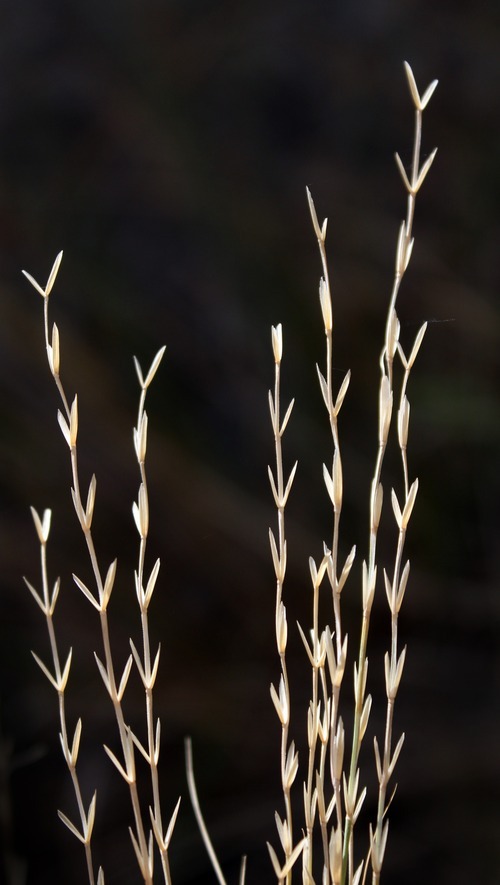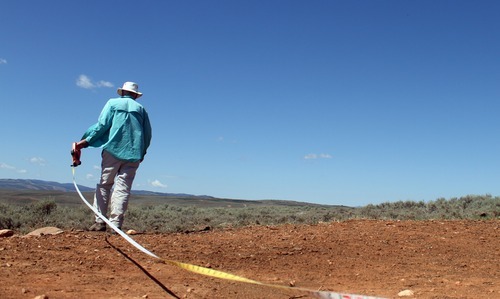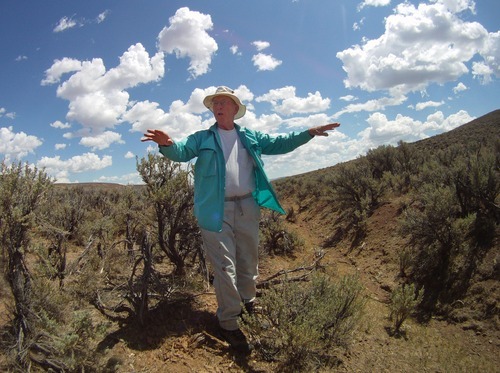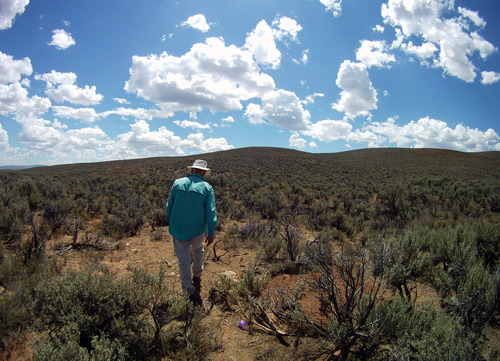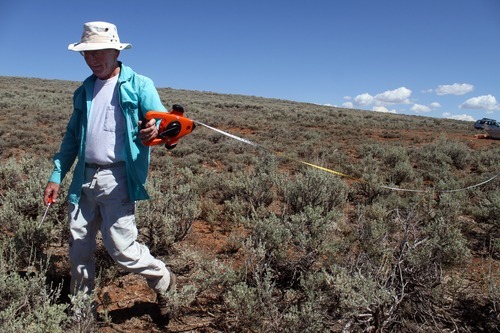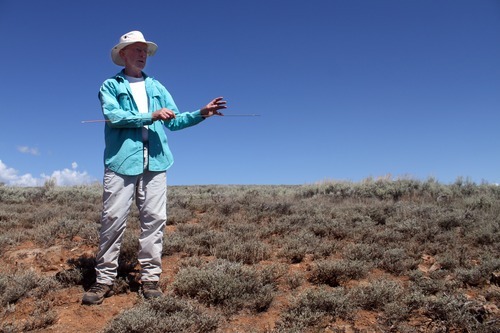This is an archived article that was published on sltrib.com in 2012, and information in the article may be outdated. It is provided only for personal research purposes and may not be reprinted.
Laketown • John Carter uses the tale of the tape to show why he believes overgrazing is a serious threat to declining sage grouse populations, despite what federal biologists say.
Scribbling data from a pasture he monitors for grass depletion, he stretched his tape measure across the ground and noted what grows precisely 73 feet from a cattle watering trough.
Nothing.
At 72 feet? A wallet-size patch of grass eaten down to an inch.
Ranchers have political power, he said, and the federal government isn't about to thwart their desires in order to protect a bird.
"If you're waiting on Fish and Wildlife Service to list species," he said, "they could go extinct."
His fear is that states like Utah, eager to adopt grouse conservation plans to appease federal biologists and avoid an endangered classification, are ignoring a key threat in cows and sheep.
Some conservation groups believe the recommendations that Gov. Gary Herbert is considering are too light on grazing rules, though members of the working group advising him say grazing was rightly a minor consideration and in some cases could even help birds.
—
Sparse cover • The rolling hills here at the U.S. Bureau of Land Management's Duck Creek grazing allotment should be a wavy sea of bluebunch wheatgrass punctuated by sagebrush — the ideal strutting grounds for increasingly rare sage grouse, said Carter, a former Western Watersheds Project ecologist who gathers data here yearly even now, in semi-retirement.
The lands could look that lush with cows present, too, given a commitment to resting alternating pastures a year or two at a time, Carter said.
"There should be lupines and arrowleaf balsamroot," he said, "a whole variety of flowering plants."
But instead there's maybe 50 percent ground cover, compared with native grasslands where he might expect to measure 90 percent. There's not much for grouse to eat, and not much more to hide them from eagles and other predators.
Sage grouse numbers have shrunk by half their historical populations across the Western sage plains, and an estimated 30 percent just since the 1980s.
Poorly managed grazing can affect their survival locally, said Pat Deibert, national sage grouse coordinator for the Fish and Wildlife Service. But, she said, the phenomenon is not a major threat on a "landscape level," across the 11 states where sage grouse live.
"There are places where grazing really is a problem," Deibert said. "But to say it's a problem on a rangewide scale is a vast overstatement."
Far higher on the government's threat list are burgeoning oil and gas well or housing developments — which eliminate or block off chunks of bird habitat.
Deibert said she would caution states not to totally ignore grazing — "It needs to be well-managed" — but in some places even wild horses are more troubling.
The working group that Herbert appointed created draft recommendations for a conservation plan, including a goal for healthy grazing lands but no specific prescriptions or restrictions on cattle in grouse habitat.
The group expects to meet once more to refine the recommendations, which would place restrictions on industry and development in certain core grouse habitats.
One such zone covers Rich County, home of the Duck Creek allotment and a ranching economy.
The idea behind that trough from which Carter stretched his tape was to lure cows out of the lowland streambeds, where they would otherwise hammer the wetlands that feed and shelter young chicks each year.
But Carter contends that without a better plan to reduce cattle numbers and rest pastures, the upland water just helps ensure that the cows wipe out more areas.
—
Little discussion • Duck Creek — the actual stream — in late summer is a steeply eroded ditch with little evidence of grass or moist ground around it. It's no good for grouse, Carter said, and he believes federal biologists know there are tens of thousands of battered streams like it across the West.
"They're engaging in willful ignorance," Carter said, "sticking their head in the sand because of political influence."
Others wish the state's draft plan would say more on the topic.
"There's some [good] in the state plan when it comes to energy development and surface disturbance," said Jim Catlin, executive director of the Wild Utah Project, "but there's nothing dealing with the largest problem, which is habitat degradation."
Overgrazing contributes to degradation in much of the state, Catlin said. The draft plan is "not very specific about what are good grazing practices and which are bad."
Joan Degiorgio, a Nature Conservancy official who represented conservationists on the state working group, said the discussion was "light on grazing" because federal biologists haven't emphasized it.
"People didn't have the conversation because the Fish and Wildlife Service did not list that as one of their major threats," she said. "I do think that we gave grazing a pass."
Utah State University biologist Terry Messmer has worked with ranchers for years to improve conditions for grouse in southcentral Utah's Parker Mountain. It worked there, he said, with help from sheep opening patches of grass in the sagebrush.
Grazing can help wildlife, he said, but it's hard to make broad statements without studies that have yet to back them up.
"Good? Bad? Ugly?" Messmer said. "[Grazing] can be all of these. But there's no good replicated study that's been done to look at the effects of grazing on sage grouse."
bloomis@sltrib.comTwitter: @brandonloomis


